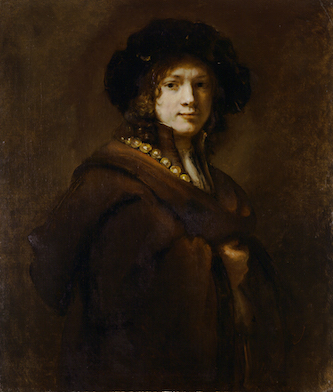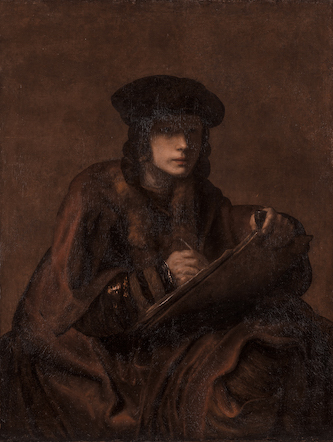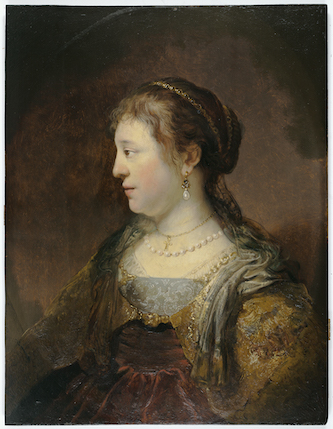Visual Arts Review: “Chasing Rembrandt” — The Hunt Continues?
By Peter Walsh
Chasing Rembrandt is a small show, probably quickly assembled to complement the TheaterWorks production. For curious viewers, though, it raises a number of provocative questions.
Chasing Rembrandt: The Wadsworth’s Quest for Rembrandt, on view at the Wadsworth Atheneum Museum of Art, Hartford, through July 23.

Attributed to Ferdinand Bol, The Departure of the Prodigal Son, n.d. Pen and brown ink, brown and gray washes, white gouache on paper. Gift of Mrs. Charles B. Wood. Photo: Wadsworth Atheneum Museum of Art
In October 1961, the Wadsworth Atheneum Museum of Art announced that it had been given three important paintings by Rembrandt van Rijn. That windfall, which had accumulated over the year, brought the museum’s total paintings by Rembrandt to four, including one it had purchased seven years earlier. In a stroke, the 1961 gifts brought the Wadsworth into the elite group of world art museums that owned a significant number of Rembrandts. Entire countries own only one. Most art museums have none at all.
How many Rembrandt paintings does the Wadsworth claim to own today? None.
No, the museum hasn’t been the victim of a Gardner Museum-like heist. At some point in the 60 years that followed the 1961 announcement, all four of the Wadsworth Rembrandts have been downgraded in status, reattributed to the master’s students or to unnamed imitators, and relegated to storage.
The Wadsworth is hardly alone in this misfortune. The Metropolitan Museum of Art owns about a dozen “generally accepted” Rembrandt paintings, one of the largest such collections in the world; but the museum counts twice as many works that came into its collection as Rembrandts but have since been ignominiously demoted, just like the Wadsworth paintings. Over many decades, scholars, curators, specialists, and committees have revised the corpus of genuine Rembrandts so many times it has become almost a parlor game. Since the 19th century, the list of sanctioned paintings has reached above 600 and has fallen as low as about 280; the consensus estimate today rests around 300.
The Wadsworth’s exhibition Chasing Rembrandt: The Wadsworth’s Quest for Rembrandt, brings its four former Rembrandts out of storage for the first time in years. Presented “in partnership” with Hartford’s TheaterWorks, which is staging the Jessica Dickey play The Rembrandt (through May 14), the small Wadsworth show also includes a disputed drawing and a case full of related documents. Together, they open a small window onto the very large landscape of Rembrandt “connoisseurship” — the old school term art historians traditionally used to denote the skills and talents needed to judge a work of art’s quality, to accurately date it, and to attribute it to a specific artist or group of artists.
Of all the Old Masters, though, Rembrandt connoisseurship is particularly challenging. The master spent most of his artistic career sharing working space and collaborating in various ways with other painters. Up to 1631, when he moved to Amsterdam, Rembrandt worked for five years in his hometown Leiden alongside his friend, fellow Leiden native, competitor, and sometime collaborator Jan Lievens. Lievens had been hailed as a prodigy before he was in his teens. For five years, the two ambitious painters, who had studied together, shared a Leiden studio and even painted parts of each other’s canvases. The gifted Lievens left Leiden for a period in London, then settled into a prosperous career in Antwerp.
Rembrandt moved on to the flourishing city of Amsterdam, where he quickly became famous and wealthy. He and his wife Saskia lived lavishly, usually beyond the artist’s means. Partly as a way to pay the bills and keep his productivity as high as possible, Rembrandt kept many pupils and apprentices around his studio, dozens over the course of his working life. The most talented of these — men like Ferdinand Bol, Gerrit Dou, Govert Flinck, and Nicolaes Maes — were able to learn the elements of Rembrandt’s style and use them to build prominent, financially successful careers of their own.

Imitator of Rembrandt van Rijn, Portrait of a Young Man, n.d. Oil on canvas. The Ella Gallup Sumner and Mary Catlin Sumner Collection Fund. Photo: Wadsworth Atheneum Museum of Art
All this leads to a host of problems in dividing the true Rembrandts from many other works that can come quite close. Because Rembrandt and his students worked in the same studio, on many of the same subjects, with the same materials, and even on the same paintings, objective, scientific methods like pigment analysis and dendrochronology — dating panel paintings through a study of tree rings — won’t work. Dutch post-Reformation artists no longer worked for the Catholic Church — Calvinist religious authorities had banned images from Dutch churches — and most painters worked in a commercial art market dominated by commoners, not royal or aristocratic patrons, as in the rest of Europe. This meant the paper trail of inventories and official records for Dutch art is thinner than for Italian or French painters.
Still, a Rembrandt is a Rembrandt. The master’s works do stand out from the crowd. Most artists, including some great ones, develop a distinct signature style and then stick with it for the rest of their careers. Rembrandt never wanted to sit still. In his early works, you can watch him absorbing influences and adopting new ideas almost from painting to painting. In his mature and late years, his paintings grew more and more powerful, even as the market began to look for something less intense. When I studied Rembrandt as an undergraduate, we were expected to identify, on the final exam, Rembrandt’s early portraits, up to about 1640, from slides we had not seen in class, and to date them accurately within two or three years. This was less difficult than it might sound.
Of the four former Rembrandt-attributed paintings in the Wadsworth show, the standout was the first to arrive at the museum, acquired in 1954 and exhibited in the current show as Portrait of a Young Man. It is signed and dated 1655, though the inscription, the label says, is no longer visible. The sitter was often assumed to be Rembrandt’s only son, Titus, a favorite model whom the figure in the painting resembles, though the subject appears a few years older than Titus’s 15 years in 1655. The young man stares directly out of the canvas, dressed in a dark velvet cap, luxurious robes, and a gold chain — a costume much favored in Rembrandt male portraits, including in other portraits of Titus and his own self-portraits. The sweetly handsome face, with its half smile and slightly creased forehead, suggests a complex inner life — a mixture of youthful confidence, anticipation, and doubt. There have also been suggestions that the sitter, Titus or not, may also have been the model for the Frick Collection’s beloved Polish Rider.
The acquisition of a major Rembrandt from his most accomplished period must have been a major coup for the Wadsworth’s well-connected director, Charles C. Cunningham Sr., himself a Rembrandt specialist. “I am indeed happy that you could acquire this impressive portrait by Rembrandt,” wrote the Harvard curator and professor Jakob Rosenberg, a leading authority on Dutch art and author of an important Rembrandt catalogue that is still in print. “I feel sure it will add to the glory of your museum.” The noted scholar, curator, and pioneering museum director W. R. Valentiner, who wrote his doctoral thesis on Rembrandt, was even more effusive in his own letter to Cunningham: “I am delighted to hear that you acquired for your museum the young man by Rembrandt dated 1655 which I always admired greatly. It is one of the most fascinating and mysterious portraits by the master marking a height among the portraits of the fifties of the 17th century.”

Attributed to Samuel van Hoogstraten, Self-Portrait (?), n.d. Oil on canvas. Gift of Robert Lehman. Photo: Wadsworth Atheneum Museum of Art
Valentiner goes on to describe and praise the painting at length, arguing for Titus as the sitter because of the “unusual well proportioned handsome face” that resembled other Titus portraits as well as Rembrandt himself. Still, something unexplained happened later that caused the Wadsworth to revisit the Rembrandt attribution. The exhibition label calls it the work of an “Imitator of Rembrandt van Rijn” and claims it is “probably a much later work, perhaps from the eighteenth century,” which suggests, along with the presumably false signature and date, that it might have been made as a forgery. Still, whoever painted the work was very familiar with Rembrandt’s portrait subjects and painting methods of the 1650s, knowledge that could not have come so easily in the 18th century, when Rembrandt and his major pupils were dead, before there were public art museums and photographs, and when most Rembrandt portraits were in private hands.
The other three paintings on view include a portrait of a young artist at work, documented through several distinguished private collections as Rembrandt but now believed to be a possible self-portrait by Samuel van Hoogstraten, a Rembrandt student in the early 1640s. The Portrait of a Woman in Profile, once thought to be of Saskia, is an accomplished work of an expensively dressed middle-aged woman, with the sparkling details of jewelry and fabrics sometimes seen in early Rembrandt portraits. It is now attributed to Flinck.
The final oil in the show, Landscape with a Cottage, labeled here as “Style of Rembrandt,” is a dramatically lit fantasy of the kind seen in Landscape with an Obelisk, stolen from the Gardner Museum in 1990 and now also attributed to Flinck. Landscape with a Cottage has been extensively reworked, its label says, making the attribution to a particular artist difficult.
The exhibition rounds out with a pen and wash drawing, The Departure of the Prodigal Son, part of an Old Testament narrative depicted many times by Rembrandt and his inner circle. Acquired in 1939 as a Rembrandt, it is now attributed to Bol.
Chasing Rembrandt is a small show, probably quickly assembled to complement the TheaterWorks production. For curious viewers, though, it raises a number of provocative questions: Why were the four paintings downgraded, and when, and by whom? What was the evidence against them? Two of the paintings seem to be perfectly respectable works attributed to members of Rembrandt’s inner circle. Why have they been hidden away in storage? Is Portrait of a Young Man a forgery, and, if so, how did it fool some of the leading Dutch art authorities of the 20th century? Did some objective evidence — a scientific study perhaps — overrule them?
Downgrading an attribution, particularly of an artist as famous as Rembrandt, can be traumatic. It can easily reduce a work’s market value by more than 99 percent, even though the painting itself remains unchanged. Museums have been known to wait until a donor, curator, or acquiring director is dead before revising a label or moving a reattributed painting to storage.
The Rembrandt Research Project (RRP), founded in 1968 in the Netherlands, was designed to use all available means, scientific and scholarly, to survey all attributed Rembrandt works and, once and for all, officially divide the genuine Rembrandts from everything else. Its efforts shocked the art world when it ruled out half of the “signed” Rembrandt self-portraits and even questioned The Polish Rider (the Frick never changed the label). RRP scholars claimed that Rembrandt maximized the production of his studio by incorporating apprentice work in his finished paintings, a standard practice at the time. The resulting controversies led many to question whether the project’s goals were even feasible, given Rembrandt’s studio practice. The RRP officially ended research in 2014 after its funding ran thin and its chair retired, without completing its survey, though its documentation has been taken over by a renamed Rembrandt Database.

Attributed to Govaert Flinck (Dutch, 1615–1660), Portrait of a Woman in Profile (possibly Saskia) (detail), c. 1636. Oil on panel. Gift in memory of Mae Caldwell Rovensky. Photo: Wadsworth Atheneum Museum of Art
Nowadays, it is typically the slow accumulation of scholarly opinion, rather than some dramatic revelation, that pushes a Rembrandt or a work by another great master out of the accepted canon. The process can take years as the assessments move from Rembrandt to others. Attribution for a particular work can bounce from artist to artist in the scholarly literature unless one expert makes a cogent case that convinces a majority of the others.
In recent years, experts have notoriously been consulted about an attribution to a famous artist only to be sued for damages by the owners when they failed to endorse it. “Discovering” a work or reattributing a painting from a minor artist to a major one can be a career killer if it is later convincingly refuted. Understandably, scholars and curators have become more circumspect about endorsing attributions than they were in Cunningham’s day.
The Wadsworth exhibition ends with an invitation to view a genuine Rembrandt on display in the Early Baroque Gallery on the museum’s second floor. When I went to see it, however, it took me several moments to find it. Even then, it was not because I recognized that it was Rembrandt, but because I realized I hadn’t seen the work before.
The oil on canvas is labeled The Return of Tobias and the Angel and it is dated 1627-35, a much wider date range than the one allowed in my undergraduate course. The subject is from the Old Testament Book of Tobit (in the Apocrypha in most Protestant Bibles), a narrative of a son’s quest to cure his father of accidental blindness. It is a favorite Rembrandt subject that was also popular with many other artists. Ascribing the painting to a “Private Collection,” the effusive label copy suggests that it might be a promised bequest or potential gift. It does not mention any extensive scholarship on the painting.
The painting, in fact, is not included in recent lists of “generally accepted” works by Rembrandt. It mixes elements found in early Rembrandt paintings — the emotional moment, the dilapidated interior, and Tobit’s exotic costume — with memes from other Dutch 17th-century painters. The work has been called “enigmatic” and has been attributed to several Dutch artists, including Flinck, Lievens, Dou, Isaac Koedijck and, recently, “convincingly,” to Pieter Verelst, a younger Dutch artist not known to have been a Rembrandt student. In his known works he combined influences, motifs, and techniques from many Dutch painters: the Leiden period Rembrandt, several of Rembrandt’s students, Adriaen van Ostade and Cornelis Saftleven, among others.
Altogether, the Rembrandt attribution here strikes me as less convincing than some of the original ones for the four paintings downstairs. Could history be repeating itself?
Peter Walsh has worked as a staff member or consultant to such museums as the Harvard Art Museums, the Museum of Fine Arts, Boston, the Davis Museum at Wellesley College, The Metropolitan Museum of Art, the National Gallery of Art, and the Boston Athenaeum. He has published in American and European newspapers, journals, and in scholarly anthologies and has lectured at MIT, in New York, Milan, London, Los Angeles and many other venues. In recent years, he began a career as an actor and has since worked on more than 100 projects, including theater, national television, and award-winning films. He is completing a novel set in the 1960s.
Tagged: Chasing Rembrandt: The Wadsworth’s quest for Rembrandt
